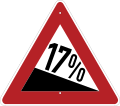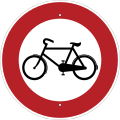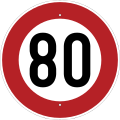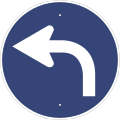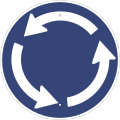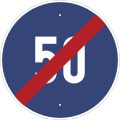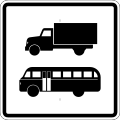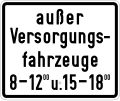Illustration of the traffic signs in the German Democratic Republic from 1971 to 1978
The picture table of the traffic signs in the German Democratic Republic from 1971 to 1978 shows the traffic signs in the German Democratic Republic (GDR) as they were after the change in the road traffic regulations that came into force on August 1, 1971 - StVO - from May 20 1971 portrayed. The structure and representation of the traffic signs in the then valid road traffic regulations (StVO) of January 30, 1964 were changed by a resolution of the Council of Ministers of the GDR , the Minister of the Interior and Chief of the German People's Police by the amendment of May 20, 1971, which was adopted on May 1 , 1964 August 1971 came into force, some profoundly changed. The 1964 StVO ceased to be in force with the introduction of the new StVO on January 1, 1978. However, the new TGL 12096/01, which stipulated the standardization of the now valid traffic signs, was only published in November 1978 and became binding on May 1, 1979. Thus, at the end of 1978 at the earliest, signs could be manufactured according to the new StVO. In addition, road traffic-relevant signs or signals of the ordinances on the construction and operation of trams (BOStrab) are reproduced in this table .
Paragraph 24/1 of the amending ordinance stipulated: “Figures 58 and 63 of Appendix 1 will be deleted.” The meaning or the images themselves have been changed for a number of other images. In fact, with the introduction of TGL 10629, which came into effect on January 1, 1968, all traffic signs in the StVO from 1964 had been revised according to new guidelines. In 1968 the arrow of the heart found its way into the symbolic design of the GDR for the first time. Another innovation was the inclusion of motorway signs in the traffic sign catalog. This signage was regulated separately beforehand. The then current West German Road Traffic Regulations had already taken the same step in terms of motorway signage with the new version of 1970, which came into force on March 1, 1971. While a new, lighter shade of blue (RAL 5017 - traffic blue) was chosen for the motorway signs in the west from 1971, those responsible in the east used the first TGL 21196 from 1969 and chose the color 1464 "Ultramarine", which is removed from the color RAL 32 h (blue) from the RAL color register 840 B 2 introduced in 1932. This RAL color, which was later called RAL 5002 (ultramarine blue), had already been used for the first German motorway signs and had also shaped the traffic signs on German motorways for decades.
Other important innovations
With the introduction of the GDR standard TGL number 10629 , which came into force on January 1, 1968, some extensive visual changes were made to the traffic signs of the StVO from 1964 . The additions introduced by the TGL were now available to sign manufacturers and enabled a large number of standardized sign arrangements. Until the introduction of the new StVO on January 1, 1978, however, only exemplary examples from the TGL were included in the road traffic regulations. In 1971 there were also additions and deletions of characters that could be found in TGL 10629 in places.
Colours
In order to break away from the standards such as RAL and DIN, which were continued in West Germany after the war and to emphasize the independence of the GDR, one of the country's major projects was to introduce new industrial standards. The mass of old standards that had to be redefined, as well as the constantly changing requirements due to innovations in research and technology, made this work a Sisyphean work . In the GDR, the DIN standards were compared with the TGL standard ( technical standards, quality regulations and delivery conditions ) for the first time from 1955 . When the new StVO was introduced in 1964, the type color card 5/62 was the first GDR-specific color standard to appear in 1962. But it was only with the mandatory requirements of the TGL 10629 (guidance systems for road traffic), which were introduced on January 1, 1968, that all the basic standards relating to traffic signs were covered for the first time. As a replacement for the older standard TGL 0-6163 from November 1962, the standard TGL 20684, sheet 6, published in February 1967 (signal lights - colors and color boundaries in traffic - stationary signal lights in road traffic) defined the color boundaries. In January 1969 the color tones were again regulated by TGL 21196 (paints - color register). The basic colors for the traffic signs of the StVO were only defined with the unspecific designations red, yellow, blue etc. With these basic colors, the desired color spectrum could be defined using the TGL 20684 and the CIE standard color chart reproduced there , and the closest color could be selected from the type color card.
- Red - TGL 21196 (1969): 0605 "Signalrot" = Lab L 44.78, a 50.80, b 26.62 (= RAL color register 840 R: 3000)
- Yellow - TGL 21196 (1969): 0209 "Chrome yellow" = Lab L 76.81, a 9.08, b 67.66 (= RAL color register 840 R: 1004)
- Blue - TGL 21196 (1969): 1464 "Ultramarine" = Lab L 37.22, a 8.32, b -27.81 (= no equivalent in RAL)
The perceptible spectrum in the 1976 CIE-Lab color space is given by TGL 21196, which came into effect on March 1, 1988. Although this last-mentioned TGL was created long after the StVO came out of force in 1964, the TGL color values were first brought into a form that could be used by image processing programs. So the color values could also be used for the illustrations in this article.
Fonts
Since the introduction of the TGL 0-1451, which became binding on January 1, 1963, those responsible in the GDR had also prescribed their own font standard for traffic signs. The TGL specifications were based directly on the pre-war standard of DIN 1451 and were borrowed from this design language. As with the DIN font weights, there were narrow, medium and broad fonts, with print types in different font weights . Practice has shown that even official images in the legal texts or other publications did not adhere to these specifications and instead many variations of the DIN script were used, as was already common practice with sign painters before the war. This was not an East German phenomenon, but could also be observed in West Germany at the same time. It was not until the beginning of the 1970s, with the advent of electronic control systems for the production of traffic signs, that the uniformity of the lettering that we know today became established. The TGL-0-1451 gives clear guidelines for the cone and font sizes of the print types. Great importance was attached to good kerning and appropriate line spacing . All of this should increase the legibility of the road signs.
Manufacturing
With the TGL 10629, announced on April 10, 1967 and binding on January 1, 1968, standardized drill holes were made mandatory in traffic signs. The illustrations on this page show these drill holes at the precisely defined locations. Only the signs used on motorways could be produced without perforation. Signs made of sheet steel were to be designed with a bead . Sheet steel signs that had to be renewed should be replaced by aluminum or " plastic " signs . According to this standard, the manufacturer's company with address, month and year of manufacture had to be weatherproof on the back.
Motorway signage
Motorway signage, which was previously regulated separately, was added to the road traffic regulations in 1971. This new regulation had its parallel to the development in the Federal Republic of Germany, in which the traffic signs for motorways had also been stipulated in the StVO since 1971. The motorway signs introduced in the GDR in 1971 remained in use until the turn of 1990, even if new signs were introduced from 1979 onwards. But since the expansion of the motorway in the GDR had no priority, only damaged signs were replaced.
I. Warning signs
II. Prohibition signs
III. Mandatory sign
IV. Signs
V. Traffic control systems
Additional signs
Fig. 99
except People's Police vehicles
Pictures without replacement
Control systems for road traffic
The TGL 12096 for guidance systems, which became binding on April 1, 1967, was not included in the road traffic regulations. The guide hatches prescribed in the TGL could be applied to signs or to the obstacles themselves. A distinction was made between yellow and black hatching on permanent obstacles such as bridge piers, parapets and rocks, and red and black hatching on shut-off devices, vehicles and work equipment.
The TGL defines an exception for white-red hatchings, in addition to their otherwise non-permanent use in the street area: their use with shut-off devices that were constantly on the road. Since the 1960s, the guiding stones have also appeared with a red and white paint. As stated in the West German ÖTV press , the central organ of the public services, transport and traffic union in 1954, natural stones that were too dark should be painted light. A similar rule may have applied in the GDR, as there, too, guiding stones were sometimes given a white shaft.
Stop signs for trams and motor vehicle lines
Subsequent changes and additions to the traffic signs
1974
With the TGL 12 096/05, which became binding on July 1, 1974, delineator posts were standardized for the first time in their design according to GDR standards, as they had been introduced in the FRG since March 1957.
1975
With the TGL 12096/04 of May 1974, which became binding from January 1, 1975, the Ampelmännchen found its way into the TGL traffic light standardization for the first time.
1976
On January 22nd, 1976 a completely new BOStrab was issued, which came into force on May 1st, 1976. The characters were given new names and numbering. The symbol for special stops has been introduced. Only the character changes to the older BOStrab are shown below.
See also
Under the title of road safety , the expended Deutsche Post of the GDR in the years 1966, 1969 and 1975, three stamp series on traffic safety .
Web links
Remarks
- ^ Legal Gazette of the German Democratic Republic Part II, No. 49, Berlin, June 4, 1964, pp. 357–372.
- ↑ Ordinance amending the Road Traffic Act - StVO - of May 20, 1971 In: Law Gazette of the German Democratic Republic , Part II, No. 51, Berlin June 22, 1971, pp. 409–415; here: pp. 409, 412.
- ↑ § 52 Entry into force and transitional provisions . In: Ordinance on behavior in road traffic (Road Traffic Regulations - StVO -). From May 26, 1977. In: Law Gazette of the German Democratic Republic , Part 1, No. 20, pp. 257 ff.
- ↑ TGL 12096/01: Road traffic systems - guidance systems - traffic signs from November 1978, pp. 1–28; here p. 1.
- ↑ BGBl. I p. 1565 , ber. 1971 I p. 38
- ^ Reichsgesetzblatt , year 1937, No. 56, date of issue: Berlin, November 16, 1937, p. 1195.
- ↑ Johannes Denecke: Lackfarben 1932-1945. In: Johannes Denecke Camouflage paints of the German army 1914 to today , Bernard & Graefe, Bonn 1999, ISBN 3-7637-5990-5 . Pp. 104-106.
- ↑ § 52 Entry into force and transitional provisions . In: Ordinance on behavior in road traffic (Road Traffic Regulations - StVO -). From May 26, 1977. In: Law Gazette of the German Democratic Republic , Part 1, No. 20, pp. 257 ff.
- ↑ See in particular: TGL 10629, sheet 2: Control systems for road traffic - traffic signs - signs; TGL 10629, sheet 3: Control systems for road traffic - traffic signs - symbols, color, writing
- ↑ TGL 21196 (June 1987): Paints - Color Register - Preferred Colors
- ^ Paul Trapp: What the road attendant needs to know about guidance systems! In: ÖTV press. Central organ of the trade union for public services, transport and traffic 5, 1954, p. 78 ff .; here: p. 78.
- ↑ Instructions for the arrangement and design of vertical guidance systems on federal trunk roads (HLB)










